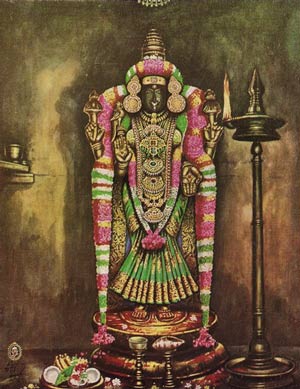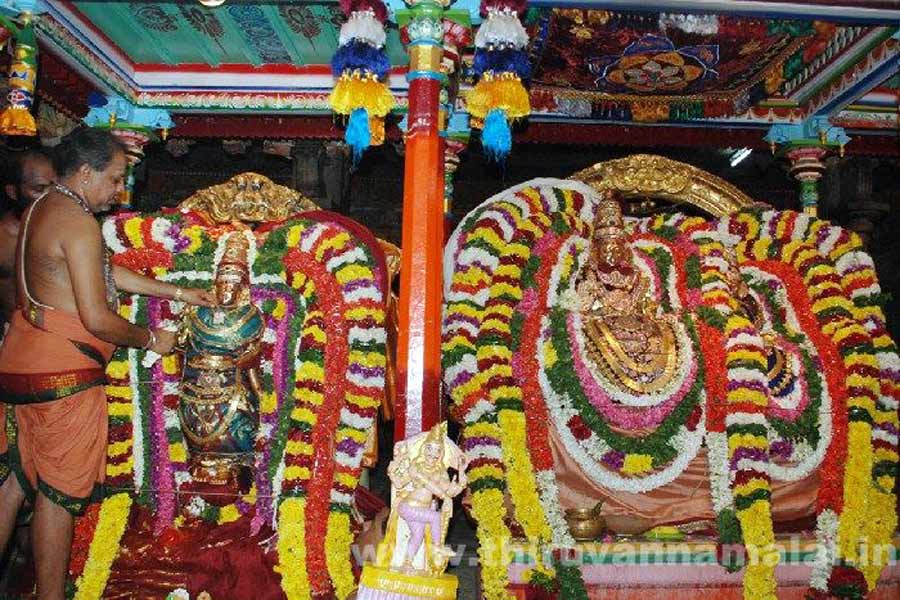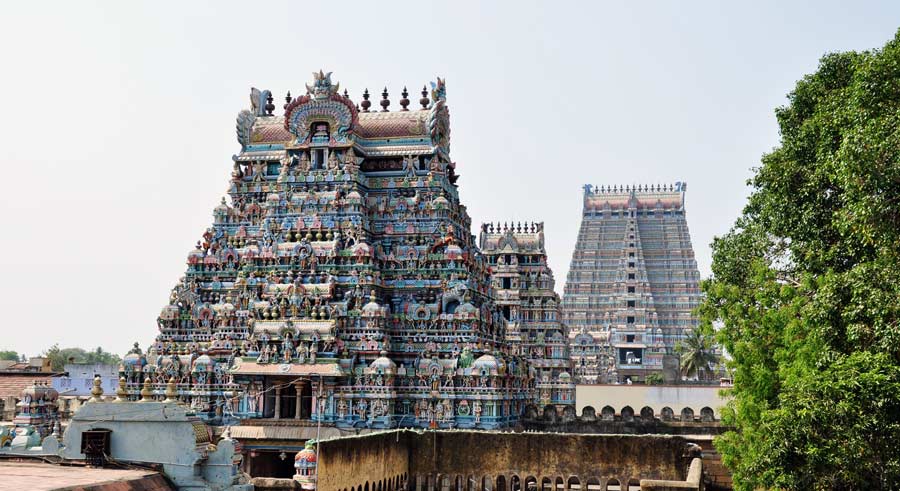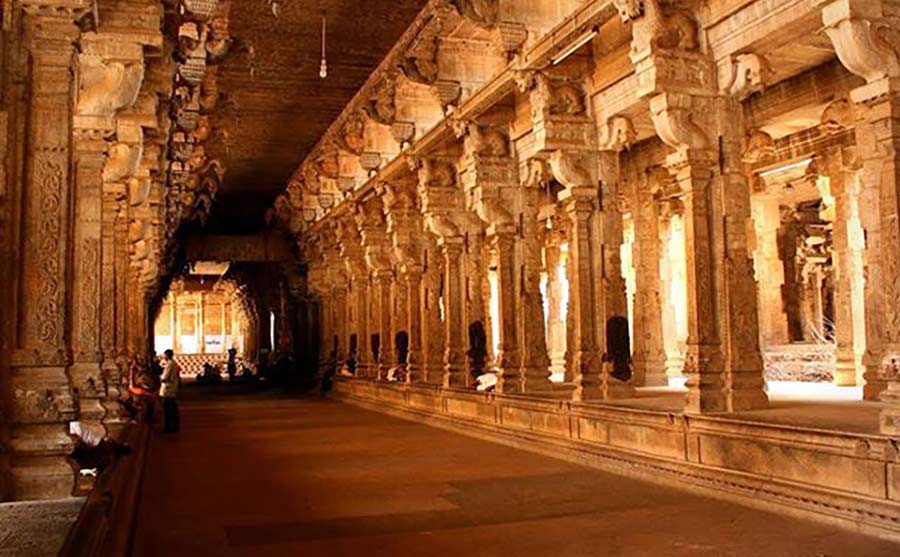Akhilandeshwari
is a South Asian Goddess who is known as ‘She Who Is Never Not Broken’. Her name references Her Universal & Cosmic powers: Akhila (Universe) Anda (Universe) Ishwari (Sovereign, Ruler). The word, akhilanda means ‘always broken’ or ‘never not broken’. The double negative
is meant to emphasize the truth of Her brokenness. It may seem strange to think of Goddess as broken. In Shakta Tantra the microcosm is the macrocosm and
Akhilandeshwari is broken because we, and the world, are broken.
It is hard to not feel broken with all the man-made crises, conflicts, disasters, and devastation happening in the world - not to mention the personal
dramas that play out in our lives. Every day we are bombarded with media images of violence, pain, and horror. Fear paralyzes us and shakes us to our core.
Our minds try to understand and rationalize the innumerable losses and atrocities; our broken hearts seek to find threads of connection, healing, and
solutions. Clearly we are all impacted by the global crises of these times. The sense of powerlessness many of us feel alongside the desired sentiments of
hope, trust and faith can be confusing, even overwhelming and often breaks us down.
What is needed to help us find our way through? How can our breakdowns lead to breakthroughs? How do we approach the challenges, pain, and difficulty that
disempowers and overwhelms us and our sisters and brothers around the globe? How do we transform the world, let alone our own fears and personal sense of
impotence into something meaningful, empowering, and liberating? When facing despair, it has helped me to turn to the millennia-old philosophical and
spiritual traditions of India, in particular the Shakta Tantra tradition that views and understands every aspect of existence as an expression of Divine
Consciousness. There are hundreds if not thousands of deities within the Shakta tradition whose iconographies, mythologies, and practices can guide us
through the very paradoxical nature of our existence here on earth. Akhilandeshwari is one of those Goddesses. What does a never not broken Goddess have to
teach us?
Akhilandeshwari is not a well-known Goddess. She is said to originally be a Vedic Goddess and is Herself a repository of knowledge. She brings us close to
Saraswati, Goddess of Wisdom and the Arts. She is also said to be the Goddess of the agamas (canonical texts also known as tantras). Like
Sharada (another emanation of Saraswati), Akhilandeshwari is dark complexioned. She has a serene smile, carries a trident and rides Her crocodile through
the rivers of life. Her crocodile assists Her with Her prey and Her trident represents Her union with Shiva as well as Her wrathful powers. One devotional
song in praise of this Goddess, called Akhilandeshwari written by Muthuswami Dikshithar, describes Her as a form of Parvati and the daughter of
the mountain God, Himavat. She is also associated with Durga. Like Durga, She can help us move through the very challenging difficulties in life. She helps
us to find the light of our essence through the cracks from the chaos.

Akhilandeshwari may have originally been a local wrathful Goddess in the village of Thiruvanaikal in Tamil Nadu, who brought illness, destruction and other
threats to the inhabitants. Today She shares a temple called Shri Jambukeshwarar Akhilandehwari Temple with Shiva. According to Annette Wilke in her essay Shankara and the Taming of the Wild Goddess, a myth describing the powers of Akhilandeshwari in this region was written by the philosopher
Shankara. He describes Her marriage to Shiva through the gift of gold earrings designed like the Sri Yantra. This myth portrays a theme that we find in
many of the later myths and legends around wild and fierce Goddesses: to control and contain them by locking them up (in a room, box, etc.) or taming and
domesticating them through marriage. Usually this theme denotes a power shift with the Goddess giving Her power over to Her husband. Once married, She
loses independence and becomes submissive and passive.
In this myth connected to Akhilandeshwari’s temple in the village of Thiruvanaikal, the local people begged Shankara to draw out the Goddess’ fierce and
destructive aspects and to appease Her. He created a Ganesha temple just opposite Hers, so the first being to catch Her eye every day would be Her son, the
Remover of Obstacles. This helped subdue some of Her destructive tendencies, but was not enough. Then, Shankara created two earrings shaped like the Sri
Yantra to draw out the wrathful energies and they were placed on the Goddess. This apparently calmed Her, and one can find the murti of Akhilandeshwari in
Thiruvanaikal wearing these earrings still today. In addition to being a symbol of Her marriage to Shiva, the earrings also signify the Divine Union of
Consciousness - between the two deities as well as through the essence of the Sri Yantra. However, unlike other Goddesses who lose their power once they
are married, Akhilandeshwari, the Never Not Broken Sovereign of the Universe, is known to be even more powerful. She is said to bring liberation from death
to both Her husband Shiva as well as to humans.

In the myth we learn that through the placement of the Sri Yantras on Her ears, Her powers are transformed from being threatening to mesmerizing, and from
having a local to a universal presence. However, it is said She only wears the earrings during the day. At night Her full powers are unleashed. This is a
Goddess who cannot be fully contained. No one can remove the destruction and the mysterious qualities of the ‘night’ or the fierceness and brokenness that
She also contains. She is the power of the Sri Yantra, eternally united with Shiva, and She contains the cyclical energies of creation and destruction.
This is a Goddess whose wings cannot be clipped, in marriage, or in Her ever-brokenness. Perhaps there is something to learn from the transformation She
undergoes from being a fearsome and formidable Goddess of the local people to one who takes on a universal role of governance.
Brokenness seems to suggest separation, but if we look closely we can see the full essence of what is ever present beneath the cracks that can lead us to
our own sense of internal sovereignty as well as to balance and union within. By first working with our own fears and intense energies, we can bring more
peace to the world as well.
Let me clarify that I write of Goddess not as an archetype, but as a vast field of Consciousness. She is not a symbol. She does not represent
something. She is much bigger. She is a force. She is Ultimate Reality. She is the Great Mother Goddess Herself. Each of Her thousands of names helps us to
access a specific field of consciousness, and each field is an aspects of Her entire Being. Goddess, as I have been taught and as I experience Her, is not
going to fulfill all of our ego’s desires nor can She be reduced to helping us achieve that desired relationship, car, job, or dream home. Nor should She
be used to chalk up horrific and painful experiences as a cosmic lesson about some spiritual ‘truth’ we have learned but not embodied.
It is disturbing how often we avoid the pain and reality of suffering by dismissing certain events (especially global ones) as ‘karmic’ or another lesson
in impermanence’. There may be truth in the karmic repercussions, or the universal laws around impermanence, but sometimes it is too tempting to skip a
step or two by completely bypassing the emotional territory that our losses and fears have triggered.
The intensity of emotions, the pain we do not want to feel, all the broken pieces in ourselves that we tend to neglect and try to push away and ignore,
this is the very territory of Akhilandeshwari -She says:
‘Look at it. Deal with it. Look at your part in this.
Look at what is broken in you and you will understand what is broken in the world. Look at how you may be contributing to these conflicts in your
ignorance, in your destructive tendencies, your addictions and denial, in your fear of anyone different than you.’
One of Her many gifts is to remind us of the power to be found in our brokenness, in the loss, the fear, and the anguish.

From the Shakta Tantra perspective, we see Akhilandeshwari’s triple power as the one who brings, is and removes the pain, loss and suffering that breaks us
down. She is a Goddess who rules over all the endings and transitions in our life: the loss of a job, family member or friend, health, home and on a larger
scale the loss of trust, hope and safety in a world plagued with violence. She guards over all those experiences in life that can knock the wind out of us,
send us reeling, crashing down, and wondering how we will ever get up. Akhilandeshwari brings and removes the deep sense of brokenness, the crushing
pressure on one’s heart, the endless mental anguish, the unexpected way one’s dreams and hopes are suddenly swept away just when we think something in life
is constant. Many want to run away from a Goddess like this, but ultimately we cannot hide. So many problems in the world come from identifying with a
false ideology that conceals what is Real. To remember what is Real through Akhilandeshwari’s and our never not brokenness, can be a
fierce and painful process. However, She gives us the courage to face not only death, but also the many deaths that happen repeatedly in our life. If we
surrender and allow ourselves to go the heart of our pain, we can find refuge in our vulnerability and in our imperfections.
Akhilandeshwari rides a crocodile, a creature that teaches us about our primal instincts and especially about fear. The crocodile is one of the most
ancient symbols of the Primordial Mother. She is fiercely protective of her kin (she is known to keep her baby crocodiles in her mouth behind her sharp
teeth). This reminds us of the protection Akhilandeshwari provides over our creative expressions when we call on Her. The way the crocodile attacks her
prey is also insightful to the Goddess’ nature. Instead of using her sharp teeth to devour, she grabs them and spins them in her jaws, disorienting and
confusing them, whipping them so totally off balance, until she drowns them.
Akhilandeshwari has her crocodile spin us in her ferocious jaws till we are so disoriented about who we are, and what we believe, we can only surrender.
Our minds, which seek to control and hold on, are forced to let go of what we perceive as real when such energies come sweeping through our lives. For when
we do not, we will most likely only create more suffering for our self and others.
Spiritual power, growth and freedom can be gained through difficult experiences and the invaluable lessons they provide. There is always a gift in the pain
we experience.
The crocodile also invites us to consider the many illusions in this life - all the appearances of things, people, and places and all of our assumptions.
She shows us that things are not what they seem to be. For Akhilandeshwari and her crocodile all the false pretenses and roles we play to appear ‘perfect’
and ‘whole’ are actually bait for Her to come shake things up so we can come back to our essence. She destroys all illusions and delusions. She reminds us
of the cyclical nature of Reality that we are experiencing in every given moment. The potential of what we are becoming is ultimately limitless. Within
that brokenness there is freedom. Everything is not so neatly ordered, controlled and contained nor does it have to be. She is not stuck in one form nor
does She want us to be. She demands that we consciously face our fears and losses, without dismissing them, running away or sugarcoating them. She invites
us to cultivate the patience of the crocodile. She invites us to see the limitless potential of being and becoming that brokenness holds. Akhilandeshwari’s
intense teachings are not to harm us, but to disorient our egos so that we can drop our attachments and come into our authentic nature.

Akhilandeshwari dwells in the space between who we were and who we are becoming. She breaks our rigidity, our calcified habits and thought patterns. She is
a Goddess of Transitions. Sadness, despair, and grief are some of Her fiercest medicines. Her teachings can feel brutal to our egos, but She truly has our
best interest at heart. No matter the loss or sense of devastation we feel, Akhilandeshwari presents us with an opportunity to look at the wild
kaleidoscopic nature of our Being. She shows us that in the splintered aftermath of any heartbreak, these disowned, disdained, feared, bereft pieces of our
self reflect back an essential aspect of who we are. Our experiences shape us.
We have choices in every moment to renew and recreate ourselves
and by extension the world.
When we remember the unlimited space behind our brokenness, we re-member, we piece back together the broken shards of our lives to form new patterns and
ways of being. The journey that unfolds once She releases us from Her jaws is deep, mysterious, soul affirming and often intensely creative. Remember She
is an emanation of Saraswati. She is a Goddess of Spiritual Knowledge and all the Arts. She will support us in all our creations.
Although She is fierce, Akhilandeshwari is not to be feared. She will give us the gift of our unlimited potential. She teaches us to be compassionate with
our self and the world. One of my favorite bhajans sung at the great humanitarian and saint, Amma’s ashrams and public programs is Amma Amma Taye, Akhilandeshwari Niye, Annapurneshwari Taye, Adi Parashakti Niye. (www.amma.org) Bhagavan Das does a beautiful version of this song
on his powerful album, Songs to the Dark Lord. Akhilandeshwari breaks us down, and after being brought to the depths of our despair, we come back
to fullness, wholeness, (Annapurna), which leads us to our essence, the primordial power of Goddess, Adi Parashakti. Like Akhilandeshwari, we are
never not broken, and there is tremendous beauty, fullness and power in that.